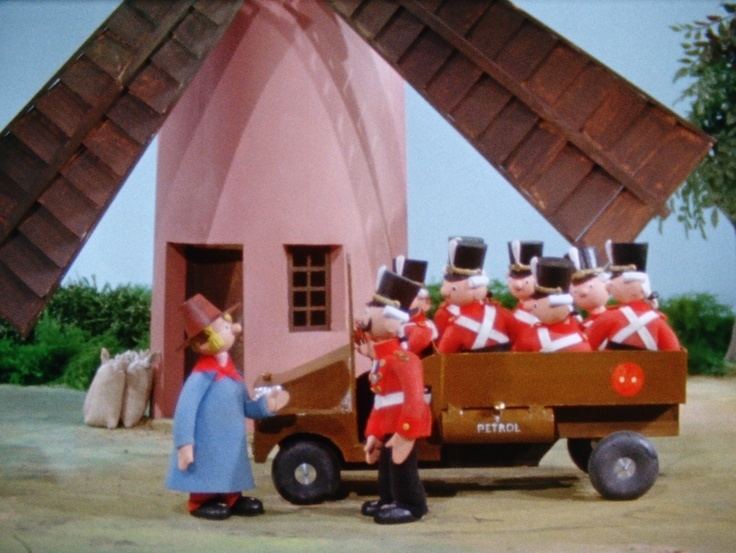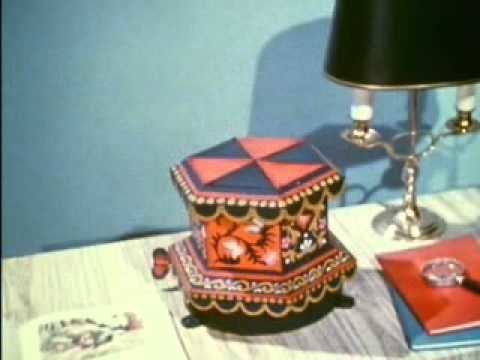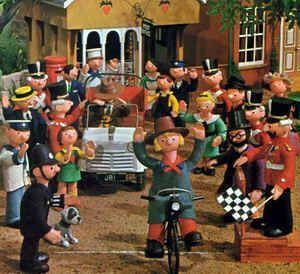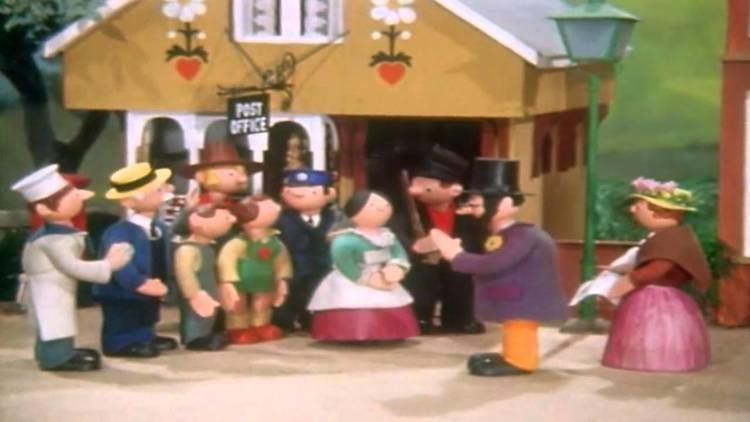8.7 /10 2 Votes
7/10 TV Original language(s) English No. of episodes 13 Final episode date 28 March 1966 | 7.7/10 IMDb Country of origin United Kingdom No. of series 1 First episode date 3 January 1966 Number of episodes 13 | |||||||||||||||||||||||||||||||||
 | ||||||||||||||||||||||||||||||||||
Similar Chigley, Clangers, Raa Raa the Noisy, Bagpuss, Rastamouse | ||||||||||||||||||||||||||||||||||
Camberwick Green is a British children's television series that ran from January to March of 1966 on BBC1, featuring stop motion puppets. Camberwick Green is the first in the Trumptonshire trilogy, which also includes Trumpton and Chigley.
Contents
- Bbc tv bbc1 bbc2 1966 camberwick green childrens programmes intro and end titles hd
- Background
- Episodes
- Modern use
- Restoration and commercial releases
- VHS
- DVD and Blu ray
- References

Bbc tv bbc1 bbc2 1966 camberwick green childrens programmes intro and end titles hd
Background

The series was written and produced by Gordon Murray and animated by Bob Bura, John Hardwick and Pasquale Ferrari. Music was by Freddie Phillips while narration and song vocals were provided by Brian Cant. There are thirteen fifteen minute colour episodes produced by Gordon Murray Pictures. The inspiration for the name is believed to have stemmed from the East Sussex village of Wivelsfield Green, supported by the nearby villages of Plumpton (Trumpton) and Chailey (Chigley).

Each episode begins with a shot of a musical box which rotates while playing a tune. It is accompanied by the following narration:

Here is a box, a musical box, wound up and ready to play. But this box can hide a secret inside. Can you guess what is in it today?
The lid of the box then opens and the puppet character that is central to the episode emerges. After a brief introduction, the background appears and the story begins.
The series is set in the small, picturesque (and fictitious) village of Camberwick Green, Trumptonshire, which is inhabited by such characters as Police Constable McGarry (Number 452), Mickey Murphy the baker and his twin children Paddy and Mary, Mr Carraway the fishmonger, Peter Hazell the postman, Mrs Dingle the postmistress and her puppy, Packet, Dr Mopp (who makes house calls in his vintage car), Mr Crockett the car mechanic, Roger Varley the chimney sweep, who travels around on a motorbike, Mr Thomas Tripp the milkman, and the town gossip, Mrs Honeyman, who is always seen carrying her baby. Just outside the village lives Jonathan Bell, owner of a "modern mechanical farm", who has a friendly rivalry with Windy Miller, owner of a clanking old – but nevertheless efficiently functional – windmill and a firm believer in old fashioned farming methods.
Mr Dagenham, a travelling salesman who drives an open-topped convertible appears just once. The staff and cadets of Pippin Fort, a nearby military academy run by Captain Snort and Sergeant-Major Grout, appear in all but one episode ("Paddy Murphy"). The series mixes contemporary technology with Edwardian costume and social attitudes. Almost all the characters have their own theme songs and travelling songs. There are two other characters who never appear in the stories; Mr Honeyman, who, according to Peter Hazell's song, "keeps the chemist shop", and an unnamed clown or pierrot who turns a roller caption to display the show's closing credits.
Each week the villagers undergo such domestic crises as a shortage of flour, a swarm of bees, a water shortage and rumours of an unwanted electrical substation being built in the village. At the end of each episode, the narrator bids farewell to the puppet character who was seen at the beginning and the latter disappears back into the musical box.
Camberwick Green has no overt fantasy content apart from the musical box. For the most part, it is simply about ordinary people doing everyday things, and perhaps for that reason it has remained popular to this day. Along with its two successors, the series was repeated many times on the BBC until 1985, and then on Channel 4 from 1994 to 2000.
Episodes
- "Peter the Postman" (3 January 1966)
- "Windy Miller" (10 January 1966)
- "Mr Crockett the Garage Man" (17 January 1966)
- "Dr Mopp" (24 January 1966)
- "Farmer Jonathan Bell" (31 January 1966)
- "Captain Snort" (7 February 1966)
- "Paddy Murphy" (14 February 1966)
- "Roger Varley the Sweep" (21 February 1966)
- "PC McGarry" (28 February 1966)
- "Mr Dagenham the Salesman" (7 March 1966)
- "Mr Carraway the Fishmonger" (14 March 1966)
- "Mickey Murphy the Baker" (21 March 1966)
- "Mrs Honeyman and Her Baby" (28 March 1966)
Episode titles were given in Radio Times, but were not shown on screen.
Modern use
The 1970s pop band Candlewick Green shares its name with the originally planned title of the series. (Murray had planned to name the show "Candlewick Green" but found that the person writing his contract had misheard and mangled the name; as he did not object to the new name, Murray went forth with the show under the mangled title.)
In 1987, Windy Miller was the face of Windmill Bakery's wholemeal bread. Ceramic pots depicting Windy hugging a beehive and barrels of marmalade and jam were made to tie in with the promotion.
Camberwick Green was spoofed for an 1988 edition of Spitting Image, as "Gamberwick Greenbelt". The ninety second sketch had a puppet Nicholas Ridley, described as "Old Nicky Ridley, the village idiot", aboard a bulldozer who then proceeded to demolish the whole village for redevelopment. In 2015, Private Eye resurrected the spoof as the "Camberwick Greenbelt" strip cartoon, offering satirical comment on social and political impacts on the British countryside.
The character Windy Miller and his famous windmill appeared in September 2005 along with some other Camberwick Green characters in commercials for Quaker Oats on television in the United Kingdom. The puppets and setting are all re creations, because Murray destroyed the originals in the 1970s. The original narrator, Brian Cant, auditioned to do the voice over for the commercials, before the job was instead given to Charlie Higson.
Episode five of the second series of the BBC's Life on Mars features a recreation of the opening of Camberwick Green, with a puppet of the show's main character, Sam Tyler (John Simm), emerging from the musical box and despairing over his colleague, Gene Hunt (Philip Glenister), who can be seen in puppet form "kicking in a nonce" at the end. This later leads to Sam to threaten Hunt, telling him to "Stay out of Camberwick Green!". It emerges that Sam is tripping after being accidentally overdosed in his hospital bed.
Again, the voice over was not supplied by Brian Cant, but is delivered in a similar style. It differs from the original by saying: "This is a box, a magical box, playing a magical tune. But inside this box there lies a surprise. Do you know who's in it today?"
The narration was provided by Brian Little, the co-founder of Hot Animation, the company that created the sequence. His recording was supposed to be a temporary guide track to help the animators time the shots, but the producers of Life on Mars were content to retain it for the final version. The one-minute sequence was designed and animated by Paul Couvela, the supervising animator of Bob the Builder.
Windy Miller cameos in the closing sequence of the 2009 BBC Children in Need charity single Peter Kay's "Animated All Star Band" video.
The music video to Radiohead's Burn the Witch pays homage to both Camberwick Green and The Wicker Man.
Restoration and commercial releases
The original masters of Camberwick Green – along with those of its sequels Trumpton and Chigley- were believed to have been lost, with most surviving copies tending to suffer from scratched, wobbly or grainy picture quality and a muffled soundtrack.
However, when boxes of some original film were discovered in Gordon Murray's attic – with more footage then discovered by the BBC – the trilogy was restored and remastered for a Blu-ray release in 2011.
VHS
In 1984, eighteen years later after the broadcasts on BBC in 1966. Longman Video released the first four episodes, as part of its Children's Treasury Collection.
Later, in 1989, the BBC released a video with the last three episodes (including E12 Mickey Murphy the Baker as the first episode, E11 Mr Carraway as the second episode and E13 Mrs Honeyman and her Baby as the last episode).
Then, in 1996–1997 Telstar Home Entertainnment, as part of its Star Kids range released three videos.
DVD and Blu ray
The digitally remastered Camberwick Green was released in December 2011 in one multi pack, comprising a Blu ray disc and an DVD.
